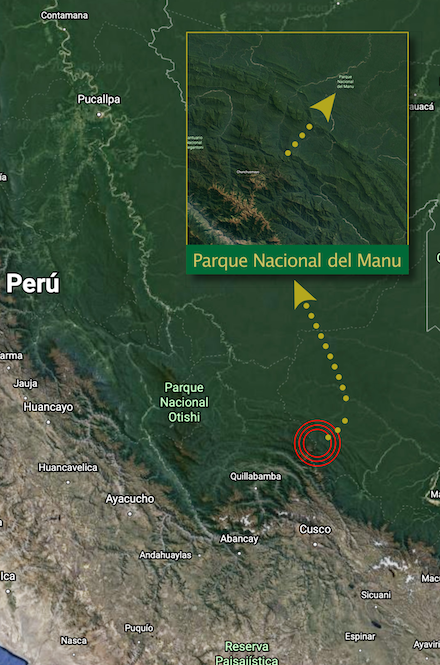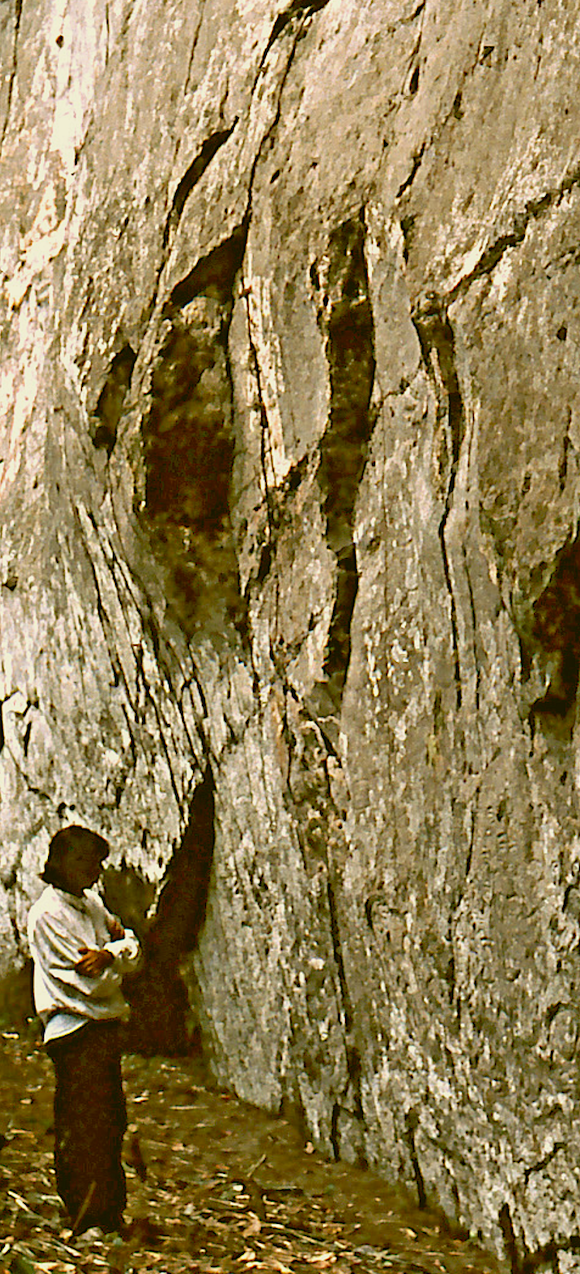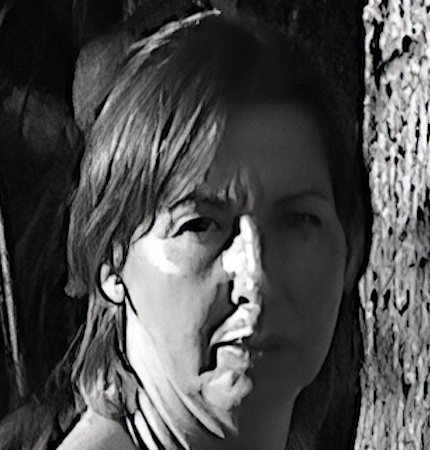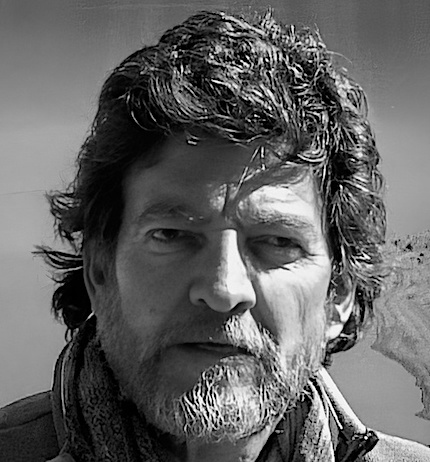THE PUSHARO PETROGLYPHS
Peruvian Amazon Rainforest, Peru
An enigma in the heart of Amazonia. Recent research provides new insights into its significance.

Ancient Amazonian Petroglyphs
Manu National Park
EXPEDITION
Pusharo Petroglyphs
The Petroglyphs of Pusharo were recognized as an archaeological heritage site by the National Institute of Culture of Peru in 2003
In the 1970s, the Petroglyphs of Pusharo, located in the heart of Machiguenga territory,
began to be publicly known, already known to this ethnic group since ancient times.
According to numerous accounts, the Machiguenga protect this place and what would be the
location of the mysterious city of Paititi, where it is believed that the last Incas took
refuge after the conquest of Peru. For many, this ethnicity descends from the Incas who
took refuge there or from those who extracted gold from the Peruvian Amazon.
Nowadays, there is a wealth of information about the Petroglyphs of Pusharo on the internet, and we
recommend the extensive article by Rainer Hostnig and Raúl Carreño Collatupa:
"Pusharo, an extraordinary rock art site in the Amazon rainforest of Madre de Dios".
At eight o'clock in the morning on a gray and rainy day at the end of November 1989, Francesc Serrat and Angela de Dalmau, accompanied by Rubén Iwaki, embarked on a unique expedition to see firsthand the origin of various speculations about the entrance to the legendary Paititi. The starting point was Cuzco, passing through Paucartambo, to descend into the Amazon on a cargo truck. We left behind the Patria farm, where Rubén Iwaki was born, and Pillcopata, and finally, after two days of travel, we reached our first objective, the community of Shintuya, on the banks of the Upper Madre de Dios River and facing the thicket of the Pantiacolla massif. Shintuya was a village that, at that time, gathered around thirty families from the Amarakaeri ethnic group in the jungle, under the administration of a Dominican mission.
On December 2, 1989, we navigated upstream on the Upper Madre de Dios River for two hours in a fragile boat called a "peque peque" until we reached the confluence of the Palotoa River. Two hours later, we were warned that we were already navigating on the waters of the Sinkivenia River (as the natives call the middle course of the Palotoa), and here we had to push the boat on numerous occasions due to the low water level. Before reaching our destination, we were forced to make two campsites on the banks of the Sinkivenia River, the last one at the confluence of this river with the Pusharo River (now also considered Palotoa). While we were setting up the second camp, a canoe with about six or seven people appeared on the river, descending in the direction of Shintuya. The surprise came when Rubén was greeted with shouts from one of the crew members in the canoe, and Rubén responded to the greeting with great joy. Our surprise was enormous, finding acquaintances in such a remote place?.
Going up the Palotoa River / Pusharo Trail to the petroglyphs
On December 3rd, we set out from our camp on a trek to the petroglyphs. We walked upstream on Pusharo, crossing the river more than five times, most with a strong current and the water up to our waists. After two and a half hours of walking through the water and rocky beaches, we arrived at a partially hidden wall behind a barrier of vegetation about 100 meters from the edge of the PUSHARO river, where we finally got to admire the petroglyphs. An impressive mural on a cliff about 30 meters high, of which only about two meters, at eye level, and a length of about 25 meters, are engraved. Unfortunately, the sand carried by the river and the rain had already covered two more meters of the petroglyphs. Rubén assured us that in '78, when he first visited the petroglyphs, they were not so covered. A friend of his had been there in '74 and also confirmed this.
The inability to find meaning in the message contained in the engravings, the large wall of stone about thirty meters high by a hundred long, leaves those who contemplate them absorbed and immersed in a torrent of speculation, reserving them for scientists.
Figures engraved in low relief, anthropomorphic faces in the shape of a heart, others expressing whimsical figures, diamonds, triangles, spirals, and circles that enclose fundamental graphics, where dots and intersecting lines predominate and even some crosses. Figures that could resemble snakes, rivers, or perhaps paths. Broken and undulating lines, making the base of this gigantic wall, a mural that presents an obvious abstract message, a graphic composition of indisputable beauty. The lush foliage around it did not allow us to observe it effectively. The sudden appearance on the opposite bank of a couple of young Machiguenga and a looming storm greatly alarmed and disturbed our Amarakaeri guides, who decided to quickly return to the camp and we could not explore the surroundings of the petroglyphs. Nowadays, two more sectors with some petroglyphs have been found nearby. We left the place almost running, as our guides marked the way, and thanks to finding the path this time, we returned to the camp in less time and quickly gathered our things. Once we were in the boat, a furious storm hit that threatened to capsize the small canoe and made us feel deep in our souls that perhaps we had desecrated a sacred place...
- Ancient Amazonian
- Pusharo Petroglyphs

Research & Interpretation
The authors, Rainer Hostnig and Raúl Carreño Collatupa, in their 2006 publication state: "The rock support, - sandstone and not granitic as it erroneously appears in the literature about Pusharo, (...) apart from the thin surface layer of silica alteration, does not present greater resistance to percussion and could have been easily worked with simple stone tools of greater hardness, such as those abundant on the banks of the Palotoa River. (...) Due to its morpho-climatic characteristics, the place is periodically flooded by the river, while the eddies formed during the flood season in front of the cliffs on both sides have repeatedly removed the soil since the petroglyphs were made; because of this, it is practically impossible to find substrates that contain evidence of archaeological artifacts, such as ceramic fragments, lithic tools, organic materials like bone remains, fabrics or charcoal from fires, which would allow a relative dating of the engravings. Any speculation about their age would be premature. (...) A detailed analysis of the engravings would allow us to determine whether our hypothesis that the petroglyphs were made in a short period of time by members of the same ethnic group, without later rock additions, with the exception of some recent fakes, is sustainable or not. (...) Ferstl (1986) describes the execution technique used as percussion or deep chiseling, possibly carried out with axes or lithic hammers with subsequent finishing done by rubbing with a stone and wet sand. This observation is valid for most of the engravings on the panel". We also highlight these words: "We agree with the Dominican father Aza (1923) who, shortly after the discovery of the Pusharo petroglyphs, (...) had concluded that the engravings are the work of an Amazonian people from the pre-Inca period. Deyermenjian (2000) agrees with this observation, mentioning that there is no indication to suspect an Inca cultural affiliation of the engravings. The fact that Inca-style stone axes have been found in the Palotoa River basin reveals the existence of Inca colonies in the area during the expansive period of the Tahuantinsuyo (1450 to 1533), but in no way can these findings be associated with the Pusharo engravings. "Quechuacentric" speculations, according to which the petroglyphs would be spatially organized according to the three levels of the Andean cosmological worldview (Hananpacha, Kaypacha and Ukuypacha), have no foundation and correspond to the perception of those who have difficulties in conceiving the existence of pre-Inca and, above all, Amazonian peoples capable of expressing their ideas and myths in a symbolic and abstract language through their own system of visual representation and a complex semantics".
Research & Interpretation
"Due to the high degree of abstraction of the graphics, it is assumed that they were the work of a culturally advanced Amazonian society that inhabited the area perhaps one or two thousand years ago. It will be difficult to establish the exact cultural affiliation of the authors and there will possibly always be doubt as to whether they were the ancestors of the Matsigenkas or members of a different ethnic group that has disappeared, leaving as the only palpable trace of their passage through the world this extraordinary rock art on the banks of the Palotoa River. We believe that the interpretation closest to reality is the one that advocates for the shamanic origin of the Pusharo engravings, as already observed by Vega Centeno (1996) and Deyermenjian (2000). In this case, and based on the writings of Reichel-Dolmatoff (1971, 1978) and Schultes & Hofmann (1992), the petroglyphs would be abstract representations of the cosmology, mythical and spiritual world depicted on the rock by the "dreamers" of the Amazonian world, possessors of a global and precise perception of the universe that is given to them at the moment of the shamanic trance produced by hallucinogenic plants (Ayahuasca or the extract of other plants). In the case of the Matsigenkas, the trance produced by these plants enables the shamans to contact the saanka'rite or protective spirits that inhabit the forest, and when the shaman, instead of taking ayahuasca (Banisteriopsis sp.) or tobacco, ingests other plant juices, he can achieve visions in which a powerful jaguar appears, who protects the Matsigenkas, but whose true form is human. (...) It is possible that a highly schematized and repetitive motif from Pusharo (T sign with a vertical appendix like a feather headdress) represents this shamanic vision of a jaguar or the transfiguration of a shaman into a feline. It is important to emphasize that the meaning of graphic symbols, metaphors, and allegories, which today seem impenetrable to us, was common and understandable to contemporary members of the ethnic group. However, the study of myths can help decipher some of the symbols. For example, the motif of the heads that appear engraved in different shapes and sizes most likely represents masks, as it was and still is a widespread custom among Amazonian peoples to represent the extrahuman beings of their myths through masks made of different materials (gourd, baked clay, wood, and tree bark). For the Piros, Shipibo-Conibos, and Matsigenkas, these mythological beings are the spiritual owners and protectors of forest resources, particularly the game animals that, as they are dangerous and ferocious, must be neutralized by the masks in which they have transformed. (Baer, 1998, Vega C. 2003:70, citing Baer). The few ethnographic data published on Pusharo are owed to researchers Baer, Ferstl, and Dubelaar (1983). (...) The authors state that, according to the Matsigenkas' belief, these petroglyphs, called Sankena'rintsi by them, were made by their cultural hero Chaenka’vane.
The natives visited the site at irregular intervals, particularly when they went hunting for a special type of monkey that inhabits this part of their communal territory. During their visits to the site, they painted some petroglyphs that they considered important (faces, puma tracks, sinuous lines indicating rivers), with a blue-black vegetable paint made from huito (Genipa americana), also used (like achiote) for facial and body paints."
Our Hypothesis
Angela de Dalmau
These latest observations lead us to the conclusion that the anthropomorphic faces in the shape of a heart are not masks, but rather refer to the faces of the Amazonian monkeys (spider monkeys, howler monkeys, woolly monkeys, squirrel monkeys, among others) that the authors of the petroglyphs hunted as their main source of food. We have used three representative species of Amazonian monkeys as an example. When we went to Pusharo, I only had knowledge about the great primates, especially the gorilla, since at that time I was actively dedicated to primatology. Nowadays, thanks to my experience with arboreal primates in South and Central America, I cannot help but see their faces in the great mural of the petroglyphs, and even their spiral-shaped tails. I also know, from extensive experience, that most, if not all, Amazonian ethnic groups feed on the monkeys that inhabit their environment. Our hypothesis is not conclusive, but with it we want to encourage future researchers to delve deeper into the cosmology and behavior of the Machiguenga people, since the petroglyphs are ultimately found in their habitat. We believe that in any research team referring to any topic about the Amazon, the presence of not only an anthropologist, but also someone with a deep knowledge of the fauna and flora of the place, is necessary. In 1989, we were looking for a map or indication in the petroglyphs that would bring us closer to the mysterious city of Paititi. We understood nothing... Today, with maturity and a broader perspective, we see in this mural the symbolic and abstract language of those who inhabit or inhabited the area.
BIBLIOGRAPHY CONSULTED • Hostnig, Rainer y Carreño Collatupa, Raúl. “Pusharo, un sitio rupestre extraordinario en la selva amazónica de Madre de Dios, Perú” En Rupestreweb, http://www.rupestreweb.info/pusharo.html 2006 • Iwaki, Rubén: “Operación Paititi” Editorial de Cultura Andina, 1975 • Neuenschwander landa, Carlos: “El Paititi en la bruma de la historia”. Editorial Cuzzi y Cía. S.A. Arequipa, 1983 • Ortega San Martín, Fernando: “PAYKIKIN, la última ciudad Inca” Ediciones Edym. 1997 • Porras G., Pedro: “Arte Rupestre, del Alto Napo- Valle de Misagualli, Ecuador”. Artes Gráficas Señal. Quito. Ecuador. 1985

